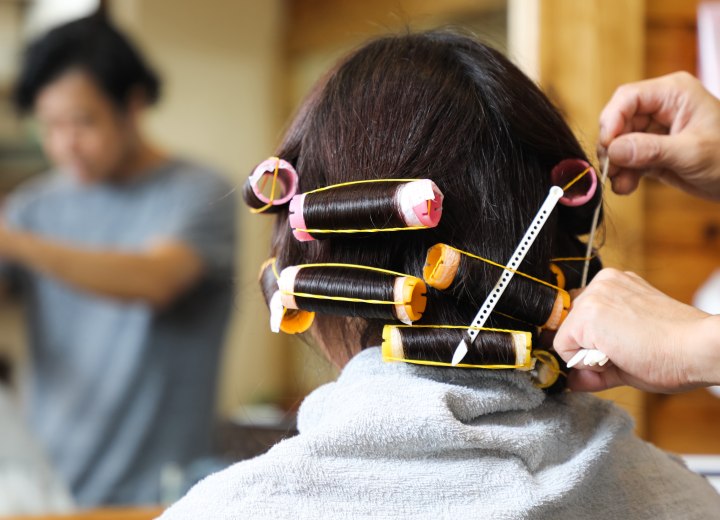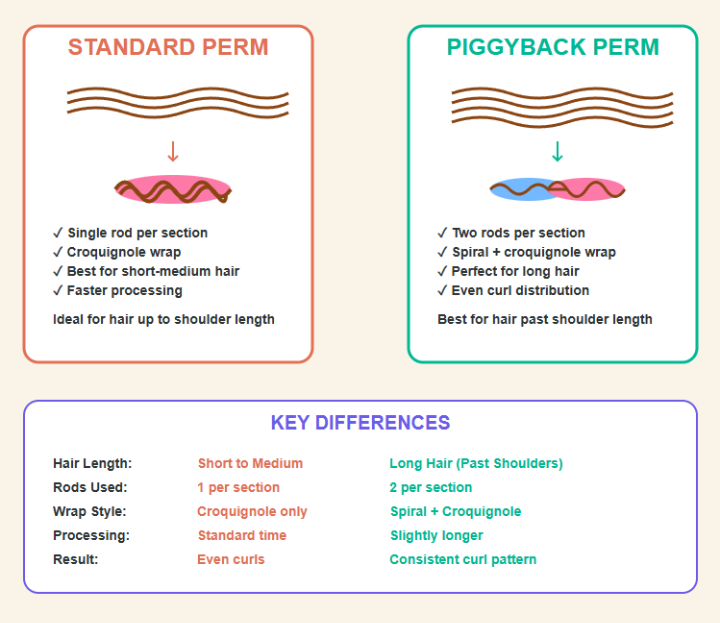Piggyback Perm

A: The fundamental difference between a standard perm and a piggyback perm lies entirely in the wrapping technique used during the chemical processing. While both methods achieve beautiful, lasting curls, the piggyback technique was specifically developed to address the unique challenges that come with perming longer hair lengths.
In a traditional perm, your stylist uses what's called a croquignole wrap. This classic method involves wrapping each section of hair around a single perm rod, starting from the ends and rolling toward the scalp. The hair naturally layers over itself as it's wound, creating overlapping sections until the entire strand is secured on the rod. This technique works beautifully for short to medium-length hair, typically anything from pixie cuts to shoulder-length styles.
The size of the perm rod your stylist chooses depends on two main factors: the type of curl you're hoping to achieve and your current hair length. Smaller rods create tighter, more defined curls, while larger rods produce looser waves. For most standard perms, one rod per section provides adequate coverage and ensures even chemical penetration throughout each strand.
Piggyback Perm Technique
The piggyback perm was invented as an elegant solution for longer hair that simply has too much length to wrap effectively around a single rod. When hair extends well past the shoulders, attempting to use just one rod often results in uneven curl distribution, with the ends becoming overly curled while the mid-lengths and areas closer to the scalp remain relatively straight.
Here's how the piggyback technique works: your stylist divides each section of hair into two portions. The first half of the hair length, from the scalp down to roughly the midpoint, gets wrapped in a spiral fashion around the first rod using an overlapping technique. This creates consistent curl formation from the roots through the middle section. Then, the remaining length of hair gets wrapped around a second rod using the traditional croquignole method, just like in a standard perm.
This dual-rod system ensures that the chemical solution can properly penetrate and process every part of your hair strand, from roots to tips. The result is remarkably even curl distribution that looks natural and balanced.

Interestingly, the finished result of a piggyback perm looks virtually identical to a standard perm when done correctly. The goal isn't to create a different type of curl pattern, but rather to achieve the same consistent, beautiful results that shorter hair naturally gets with traditional perming methods.
Without the piggyback technique, longer hair often ends up with what stylists call "perm graduation": tight, sometimes frizzy curls at the ends, looser waves through the middle, and nearly straight hair near the roots. This uneven result occurs because the hair wrapped on the outside layers of a single rod doesn't receive the same level of chemical processing as the hair in the inner layers.
With a piggyback perm, you'll see smooth, even curls that flow naturally from your scalp to your ends. The curl pattern remains consistent throughout the length, creating an appearance that looks like your hair naturally grows this way.
©Hairfinder.com
See also:
How to wrap a perm
Rod to roller perm
How to wrap a spiral perm